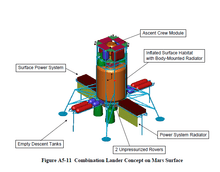Mars habitat


A Mars habitat is a place that humans can live in on Mars.[2] Mars habitats must contend with surface conditions that include almost no oxygen in the air, extreme cold, low pressure, and high radiation such as cosmic rays.[3][4] Alternatively, the habitat may be placed underground which helps solve some problems but creates new difficulties.[5]
Overview
One of the challenges for Mars habitats is maintaining the climate, especially the right temperature in the right places.[6] Things like electronics and lights generate heat that rises in the air, even as there are extreme temperature fluctuation outside.[6][7]
Technologies
Breathing gas
While it is possible for humans to breathe pure oxygen, a pure oxygen atmosphere was implicated in the Apollo 1 fire. As such, Mars habitats may have a need for additional gases. One possibility is to take nitrogen and argon from the atmosphere of Mars; however, they are hard to separate from each other.[8] As a result, a Mars habitat may use 40% argon, 40% nitrogen, and 20% oxygen.[8]
Another concept for breathing air is to use re-usable amine bead carbon monoxide scrubbers.[9] While one carbon monoxide scrubber filters the astronauts air, the other is vented to the Mars atmosphere.[9] (Argox)
History

One early idea for a Mars habitat was to use put short stay accommodation in a Mars ascent-descent vehicle. This combination was called a Mars Excursion Module, and also typically featured other components such as basic rover and science equipment. Later missions tended to shift to a dedicated descent/ascent with a separate habitat.
In 2013 ZA architects proposed having digging robots build a Mars habitat underground.[5] They chose an interior inspired by Fingal's Cave and noted the increased protection from high-energy radiation below ground.[5] On the other hand, the issue of the difficulty of sending digging robots that must construct the habitat versus landing capsules on the surface was also noted.[5] An alternative may be to build above ground, but use thick ice to shield from radiation but with advantage that it lets visible light in.[2]
In 2015 the SHEE project noted the idea of autonomous construction and preparation for Mars habitat versus human construction.[10]
NASA competitions and programs
_cropped_androtated.jpg)
In early 2015 NASA outlined a conceptual plan for three stage Mars habitat design and construction award program.[11] The first stage is a design only, then in the next stage a construction technology based using discarded spacecraft components is conducted, and finally building an actual habitat for Mars using 3D printing technology.[11]
In September 2015, NASA announced the winners of its 3-D Printed Habitat Challenge.[12] The winning submission titled 'Mars Ice House' by Clouds Architecture Office / SEArch proposed a 3D-printed double ice shell surrounding a lander module core.[2] Two European teams were awarded runner up prizes.[12] The contenders explored many possibilities for materials, with one suggesting separately refining iron and silica from the Martian dust and using the iron to make a lattice-work filled in with silca panels.[13] There were 30 finalists selected from an initial pool of 165 entries in the habitat challenge.[14]
The second-place winner proposed the printing robots build a shield out of in-situ materials around inflatable modules.[15] Another NASA project that has developed extraterrestrial surface habitats is the X-Hab challenge and the Habitation Systems Project.[16][17]
The Sfero House by Fabulous also a contender in the 3D Mars Habitat program, featured levels above and below ground level.[18] The proposed location was Gale crater (of Curiosity rover fame) with a focus on using both in-situ iron and water which would hopefully be available there.[18] It has a double walled spherical design filled with water to both keep the higher-pressure of Mars habitat in, but help protect against radiation.[18]
Analog Mars missions

Mock Mars missions or Mars analog missions typically construct terrestrial habitats on Earth and conduct mock missions, taking steps to solve some of the problems that could be faced for one on Mars.[20]
Biodomes
One example concept that is or is in support of habitat is a Mars biodome, a structure that could hold life generating needed oxygen and food for humans.[21] An example of activity in support of this goals, was a program to develop bacteria that could convert the Martian regolith or ice into oxygen.[21]
In-situ resources
One idea for supporting a Mars habitat is to extract subterranean water, which could then be processed into different chemicals, especially breathable oxygen.[22] Iron has also been suggested as a building material for 3D printed Mars habitats.[18]
See also
- Space architecture#Martian
- Mars analog habitat
- List of Mars analogs
- ESO Hotel
- Martian lava tubes
- Space Launch System
- Delta IV Heavy
- Ion thrusters
- Lemnoideae (aka duckweed, proposed for consumption on Mars)
References
- ↑ "Photo-s89_51054". Spaceflight.nasa.gov. Retrieved 2015-11-08.
- 1 2 3 "3D-printable ice house could be our home on Mars". cnet.com. September 29, 2015. Retrieved 2015-11-20.
- ↑ Fecht, Sarah (2015-09-16). "8 Printable Martian Habitat Designs That We Want To Live In | Popular Science". Popsci.com. Retrieved 2015-11-08.
- ↑ "Real Martians: How to Protect Astronauts from Space Radiation on Mars". nasa.gov. NASA. September 30, 2015. Retrieved December 2, 2016.
- 1 2 3 4 Shubber, Kadhim. "Concept for underground Mars habitat marks dawn of Martian mole-people (Wired UK)". Wired.co.uk. Retrieved 2015-11-08.
- 1 2 "The Challenges of Climate Control in a Mars Habitat - Field Notes". Blogs.discovermagazine.com. 2013-07-15. Retrieved 2015-11-08.
- ↑ "Eight Universities Selected for NASA's 2016 X-Hab Academic Innovation | NASA". Nasa.gov. Retrieved 2015-11-08.
- 1 2 "The Caves of Mars - Martian Air Breathing Mice". highmars.org. Archived from the original on 24 July 2007. Retrieved 12 June 2015.
- 1 2 Courtland, Rachel (2015-09-30). "Suiting Up for the Red Planet - IEEE Spectrum". Spectrum.ieee.org. Retrieved 2015-11-08.
- ↑ Future Mars Explorers Could Live in Habitats That Build Themselves
- 1 2 "NASA Offers $2.25 Million For Martian Habitat Design - How Could This Contest Help People On Earth? : SCIENCE". Tech Times. Retrieved 2015-11-08.
- 1 2 "NASA Awards Top Three Design Finalists in 3D Printed Habitat Challenge | NASA". Nasa.gov. Retrieved 2015-11-08.
- ↑ Fecht, Sarah (2015-09-16). "8 Printable Martian Habitat Designs That We Want To Live In | Popular Science". Popsci.com. Retrieved 2015-11-08.
- ↑ "3D-printed ice habitat concept for Mars draws acclaim from NASA". ScienceAlert. 2015-10-02. Retrieved 2015-11-08.
- ↑ "Top 10 Mars habitats from NASA space habitat challenge". Telegraph. Retrieved 2015-11-08.
- ↑ "NASA - eXploration Habitat (X-Hab) Academic Innovation Challenge". Nasa.gov. Retrieved 2015-11-08.
- ↑ "NASA - Habitation Systems Project - NASA's Deep Space Habitat". Nasa.gov. 2012-12-11. Retrieved 2015-11-08.
- 1 2 3 4 3D-printed bubble house proposed for living on Mars
- ↑
- ↑ "Mock Mars mission: Utah habitat simulates life on red planet". CBS News. 2014-01-03. Retrieved 2015-11-08.
- 1 2 "Need Oxygen On Mars? Get It From Bacteria! : SCIENCE". Tech Times. Retrieved 2015-11-08.
- ↑
Further reading
- Human utilization of subsurface extraterrestrial environments (2002 NIAC Paper on living underground on Mars)
- Human Utilization of Subsurface Extraterrestrial Environments
- 30 concepts for 3D printed habs
- Plants for food in space
- First Mars Habitat Architecture (AIAA-2015-4517) (reviews various Mars habs and technology, 2015]
External links
- Life in a sealed container - NASA (2010)
- Telegraph Photo Gallery of Mars Habitats
- Habitat Demonstration Unit (NASA)
- Mars Habitat NASA-CR-189985 (.pdf)
- Mars Ice House by Clouds Ao and SEArch project site
- Human health and radiation report (October 2015) (NASA)
- Norman and Fosters 3d printed Mars habitat design
